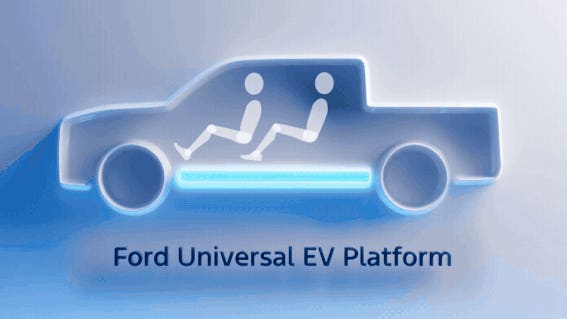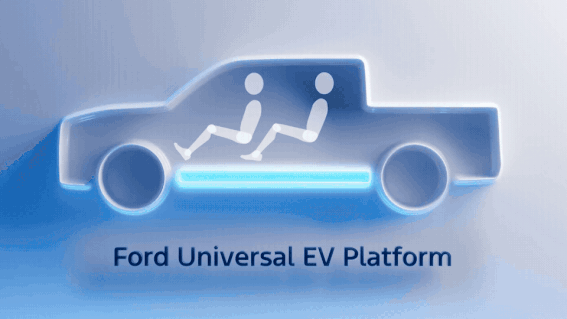Ford Universal EV Platform graphic
Ford
Back in 2019, a startup called Lordstown Motors showed off a full-size electric pickup truck that it planned to build in a former GM assembly plant in Ohio. In spring 2021, Ford showed a small group of analysts and media the F-150 Lightning and all prospects for Lordstown to succeed were immediately dashed. With the announcements being made at Ford’s Louisville Assembly Plant today, the Dearborn automaker may have just done the same to another startup, Slate that made a huge media splash this spring. In 2026, Ford will spend $5 billion to retool the Louisville plant to build vehicles based on what it is now calling its Universal EV Platform.
The Universal EV Platform is the product of much touted skunkworks that Ford established in Long Beach, California to develop its next generation of electric vehicles. If Ford is actually able to execute on its plan, the first product from this platform could be the death knell for Slate. When it was announced, the Slate truck was touted as starting under $20,000 after the federal EV tax credits. Unfortunately for Slate, just a couple of months after the introduction, the US Congress passed a tax and spending bill that kills those federal incentives for buying an EV less than two months from now while the truck won’t arrive until late 2026.
That means buyers will be spending at least $27,000 (as it’s currently priced although that could change) for a two-door, unpainted pickup with manual windows and no infotainment system. Most customers will probably end up paying prices closer to the mid-$30,000 range. Those are prices comparable to Ford’s already popular Maverick compact that has four doors and can seat four (or five in a pinch).
The first product from the Ford Universal EV Platform is a mid-size pickup truck that the company announced about a year ago when it also announced it was cancelling a three-row electric SUV program and to focus on the new platform. That truck is now planned to start production around the end of 2026 and go on sale to customers in 2027.
At the moment, Ford is saying the new electric truck will have a starting price of about $30,000, placing it right between the $28,145 starting price of a Maverick and the $33,350 entry point for the mid-size Ranger. We haven’t seen what it looks like, but Ford says it will have more interior space than the Toyota Rav4 which has 98.3 cubic feet in the 2025 model. The current Ranger has 98.9 cubic feet of passenger space so we can assume the new truck will be somewhere around 100 cubic feet although Ford says that it will have a footprint closer in size to the Maverick which is about 200-inches long. Like the Lightning the new truck will have a frunk as well for enclosed storage.
What we can also assume is that while the new Ford will probably be fairly minimalist, following the pattern of Tesla and Chinese automakers in moving as much as possible into the touchscreen interface, it won’t follow the Slate route. It will be painted and will have an infotainment system plus we already know it has four seats that will be much more appealing to consumers. Even in base form, Ford will almost certainly offer more than Slate, including range.
Ford spokesperson Emma Berg added, “We do not believe that you need to strip out features, functionality, screens or even seats to make a vehicle affordable. We will achieve affordability by radically simplifying parts and process. Our four-door midsize electric truck – when bought brand new at launch – is forecasted to have a better five-year total cost of ownership than a three-year-old used Model Y.”
How are they getting cost down?
When it launched the Lightning, Ford promised a starting price for the work truck of $40,000, but within months, the Russian invasion of Ukraine caused a spike in mineral prices that led to higher battery costs and a corresponding increase in the price of the trucks. This time, Ford has apparently learned a lot from the way Tesla and many Chinese automakers are building electric vehicles. In 2022, Tesla was the first automaker to adopt an architecture consisting of two large aluminum die castings for the front and rear structure and a structural battery pack that comprises the floor.
The Universal platform is doing the same thing. That means this won’t be a body-on-frame truck like the Ranger or F-Series, but will be more like the Maverick albeit a bit larger. Instead of a floor panel in the body in the white, the battery pack itself will make up the floor of the truck.
When we visited the still under construction Blue Oval Battery Park factory in Marshall, Michigan in June, we learned that Ford is not only producing lithium iron phosphate cells but full battery packs there. These structural packs will be shipped to Louisville for vehicle assembly. The Marshall plant has a capacity of 20 GWh per year and is scheduled to supply eight different models comprising 240,000 units per year in the coming years. That’s an average of 83 kWh per vehicle.
The battery is being manufactured in a different way from Ford’s other packs. Instead of pouch cells using a nickel-manganese-cobalt (NMC) cathode chemistry, the new cells are rectangular prismatic cans with lithium iron phosphate (LFP) chemistry. LFP has about 30% less energy density than NMC, but it is much more stable and safer. That means the cells don’t need to be packed into separate modules to isolate them and try to prevent thermal runaway if they are damaged or defective. The prismatic LFP cells can be packed directly into the outer battery case allowing more cells to be installed. The result is fewer parts, and twice as much of the pack volume being active cell material that stores energy. The combination of LFP being about 30-40% cheaper per kWh than NMC and the simplified back architecture should probably yield about a 50% cost reduction compared to the batteries currently used in the Mustang Mach-E and Lightning.
Ford is emphasizing the efficiency gains in this new platform which includes advancements in motor and power electronics that should enable this truck to deliver close to 300 miles of range on a charge if it has a battery in that 83-kWh area although Ford isn’t giving any specs at the moment. One thing Ford has revealed is that the platform has a 400V architecture, another cost saving measure compared to some of the 800V systems on the market, but that should still enable charging speeds approaching 200-kW.
How are they building it?
The Louisville plant currently builds the Ford Escape and Lincoln Corsair on traditional transfer lines. In this process, the body is loaded on one end of the line and components and systems are gradually added as the line moves until a complete vehicle rolls off the other end. It’s not a fundamentally different concept from the way the Model T was built a century ago.
Ford Universal EV Production System
Ford
Starting late this year, production of the Escape and Corsair will end in Louisville and Ford will be removing the traditional assembly line and replacing it with what it calls an assembly tree. The Ford Universal EV Production System will consist of three parallel sub-assembly lines. These will be used to assemble the front structure, rear structure and the battery and interior. Like other leaders in the EV space, Ford is adopting large scale aluminum die castings that replace dozens or hundreds of smaller stamped and cast components that have to be welded together. Tesla calls this “gigacasting”, but that is just a marketing term with no inherent meaning.
Like Tesla, Xpeng and others, the carpet, seats and most of the interior will be installed directly onto the top of the structural battery case. This will make assembly much easier since those components don’t have to be maneuvered through the door openings. Ford is also using a simplified zonal electrical/electronic architecture. This is a separate development project from a similar system called FNV4 that Ford cancelled earlier this year. Instead of a complex wiring harness with dozens or upwards of 100 electronic control units, a zonal system is more consolidated with just a small handful of ECUs. Last year Rivian adopted a similar system for the revamped R1 series that reduced the system down to four main ECUs and three zone controllers. Ford’s executive director of Advanced EV Development Alan Clarke has stated that the new platform will eliminate 4,000 ft of wiring.
At the end of the three sub-assembly lines, the structures are joined together to produce the complete vehicle. This approach will make it easier to utilize different variants of the front and rear structures for different vehicle form factors like SUVs and perhaps even cars. In total, Ford is investing $2 billion in Louisville along with the $3 billion around being invested in Marshall and other facilities.
Ford is likely to be the first legacy automaker to take this approach to building electric vehicles. If it can execute on its plans (something that is much easier said than done), it has the potential to significantly undercut both traditional competition like GM and Stellantis as well as Tesla, Slate and others. Even without federal tax incentives, these are vehicles that are price competitive with internal combustion vehicles and could even be profitable. If electric vehicles are to succeed in a US market that has one side of the political spectrum fighting to kill the technology, this approach needs to work for Ford. The future competitiveness of the US auto industry depends on it.









